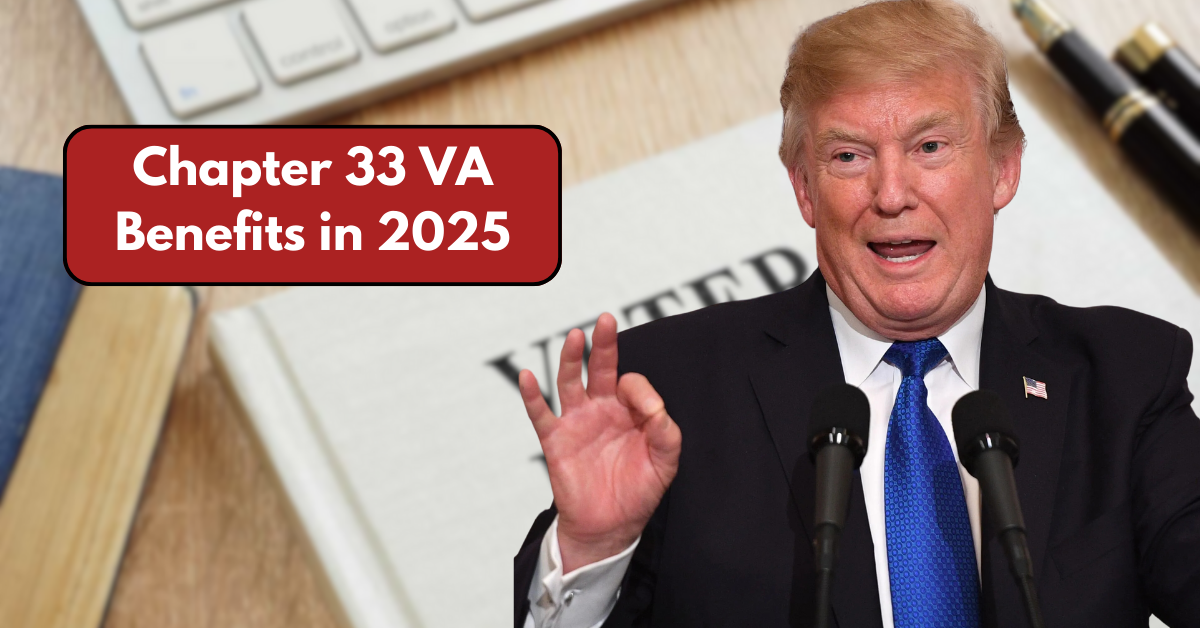The Chapter 33 VA Benefits, commonly known as the Post-9/11 GI Bill, provide financial assistance to veterans for education, training, and career advancement.
In 2025, these benefits remain a lifeline for veterans and their families, covering tuition, housing, and other expenses. Here’s everything you need to know about these benefits, their eligibility criteria, and the updates for this year.
What Are Chapter 33 VA Benefits?
Chapter 33 VA Benefits help veterans who served on active duty after September 11, 2001. These benefits include:
- Tuition Coverage: Full tuition for public universities and partial tuition (up to $28,937.09 annually) for private institutions.
- Housing Allowance: Monthly Basic Allowance for Housing (BAH) based on the E-5 pay grade with dependents, adjusted by location.
- Books and Supplies: A yearly stipend of $1,000 for study materials.
- Relocation Assistance: A one-time $500 grant for veterans moving to attend school.
These benefits are designed to support veterans in traditional degree programs, vocational training, apprenticeships, and non-degree courses.
Source: Marca
Who Is Eligible for Chapter 33 VA Benefits?
To qualify for Chapter 33 VA Benefits, veterans must meet certain service requirements:
- Minimum Active Duty Service: Veterans must have served at least 90 days on active duty after September 11, 2001.
- Purple Heart Recipients: Veterans awarded the Purple Heart are eligible regardless of their length of service.
- Service-Connected Disabilities: Veterans honorably discharged due to a service-connected disability after at least 30 days of continuous service also qualify.
- Dependent Benefits: Dependent children of qualifying veterans can access transferred benefits.
How Service Length Affects Benefits
The percentage of benefits a veteran receives depends on the length of their active duty service:
| Service Duration | Percentage of Full Benefits |
|---|---|
| 36 months or more | 100% |
| 30–35 months | 90% |
| 24–29 months | 80% |
| 18–23 months | 70% |
| 6–17 months | 60% |
| 90 days to 5 months | 50% |
This ensures that veterans with longer service receive the maximum financial support.
Additional Support: Yellow Ribbon Program
The Yellow Ribbon Program is an extra benefit for veterans attending private institutions with tuition costs exceeding the annual limit of $28,937.09. Through this program, the VA partners with schools to cover additional tuition and fees, reducing the out-of-pocket expenses for veterans.
What Will Change in 2025?
The current benefit rates will remain valid until July 31, 2025. Starting August 1, updated rates will reflect economic changes to ensure that veterans receive adequate financial support. It’s essential for veterans to stay informed about these updates to maximize their benefits.
Source: Disability Law Group
How to Apply for Chapter 33 VA Benefits
Veterans and their dependents can apply for Chapter 33 VA Benefits using VA Form 22-5490. This form is used to access education benefits, including the Post-9/11 GI Bill.
- Essential Documents: Applicants need their service records, Social Security numbers, and school enrollment information.
- Submission Methods: Applications can be submitted online, by mail, or through a VA office.
Why Chapter 33 VA Benefits Matter
Chapter 33 VA Benefits offer more than just financial assistance—they provide veterans with opportunities to build new careers, gain education, and transition to civilian life. By covering costs for tuition, housing, and supplies, these benefits ensure that veterans and their families have access to essential resources for success.
Final Thoughts
In 2025, Chapter 33 VA Benefits remain a valuable resource for veterans. Whether you’re looking to complete a degree, enroll in vocational training, or take part in an apprenticeship, these benefits offer comprehensive financial support. Veterans should ensure they meet the eligibility criteria and stay updated on upcoming changes to make the most of their benefits.
For those considering higher tuition private colleges, programs like the Yellow Ribbon Program provide additional support, making education accessible to all eligible veterans.
Veterans and their families should not miss out on these life-changing opportunities. Applying is straightforward, and the benefits can significantly ease the financial burden of education and career development.
This article has been carefully fact-checked by our editorial team to ensure accuracy and eliminate any misleading information. We are committed to maintaining the highest standards of integrity in our content.
Filza specializes in simplifying financial topics for everyday readers. Whether breaking down Canada’s tax guides or U.S. benefits like SNAP and VA Disability, Filza’s relatable writing style ensures readers feel confident and informed. Follow her insights on LinkedIn or reach out via email at shewrites.health@gmail.com.
